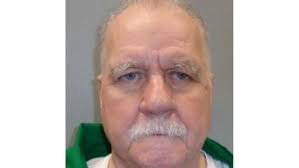The United States is set to carry out its first firing squad execution in 15 years, as a man convicted of murdering his ex-girlfriend’s parents in 2001 is scheduled to be put to death in South Carolina. This marks a return to the use of firing squads, a method of execution that has been largely dormant since the last such execution in Utah in 2010.
Brad Sigmon, 67, will be executed at a prison in Columbia, the capital of South Carolina, on Friday. He was convicted of the brutal murders of David and Gladys Larke, who were killed in 2001. The couple was beaten to death with a baseball bat, a crime that shocked their community. Sigmon, who confessed to the murders and admitted his guilt during his trial, has now been sentenced to death.
In South Carolina, those on death row are given a choice between three methods of execution: lethal injection, the electric chair, or a firing squad. Sigmon was presented with these options, and after careful consideration, he chose the firing squad as his preferred method of execution.
Gerald “Bo” King, one of Sigmon’s lawyers, explained that the decision was a difficult and distressing one for his client. Sigmon was essentially forced into an “impossible” situation, according to King. The electric chair, which has been in use in South Carolina for many years, is known for causing a particularly gruesome and painful death. King described it as a method that would “burn and cook him alive.” On the other hand, lethal injection has been a controversial method recently, as there have been concerns about the potential for prolonged and painful deaths, which have occurred in recent executions in the state.
In King’s view, Sigmon was left with the grim reality of having to choose between two forms of execution that he described as equally cruel and inhumane. Faced with this, Sigmon chose the firing squad, which, while undoubtedly violent, is seen by some as a more straightforward and less torturous method than others.
Firing squad executions have been rare in the United States, and their use has been controversial. The last time the U.S. carried out an execution by firing squad was in Utah in 2010. This method has been used a few times in the past, particularly in Utah, where executions by firing squad took place in 1996 and 1977.
The 1977 execution of Gary Gilmore in Utah became widely known after it was the subject of the book The Executioner’s Song by author Norman Mailer. Gilmore’s death marked a turning point in American capital punishment history, as it was one of the first executions in the modern era following the reinstatement of the death penalty in 1976.
While the vast majority of executions in the U.S. are carried out by lethal injection, some states have opted to explore alternative methods, such as the firing squad, in light of problems with lethal injection drugs. South Carolina, in particular, has found itself at the center of this debate. The state has authorized the use of firing squads and renovated its death chamber to facilitate this execution method.
The South Carolina Department of Corrections (SCDC) has made significant changes to the death chamber in preparation for Sigmon’s execution. The chamber now includes bullet-resistant glass between the witness room and the execution area. Sigmon will be strapped to a metal chair, and a hood will be placed over his head. He will be positioned 15 feet away from a wall with a rectangular opening. A three-person firing squad, consisting of SCDC volunteers, will be stationed behind the wall. Each member of the squad will fire a live round through the opening.
The aim point for the firing squad will be above Sigmon’s heart, where a member of the execution team will mark the spot. This method of execution, while not widely used in recent years, has been authorized in a few other states, including Utah, Idaho, Mississippi, and Oklahoma.
The return of the firing squad is part of a larger trend in the United States concerning capital punishment. Executions in the U.S. have declined significantly in recent years, and there is growing opposition to the death penalty in some states. Currently, 23 states have abolished the death penalty altogether, and three more—California, Oregon, and Pennsylvania—have placed a moratorium on executions. Despite this, several states, including Arizona, Ohio, and Tennessee, have recently announced plans to resume executions after halting them for some time.
In South Carolina, where Sigmon is set to be executed, the death penalty remains a legal and active form of punishment. Five executions have taken place in the U.S. this year alone, and 25 executions were carried out last year. While this number is significantly lower than in the past, the debate surrounding the death penalty continues to intensify, with some arguing for its expansion, while others call for its abolition.

